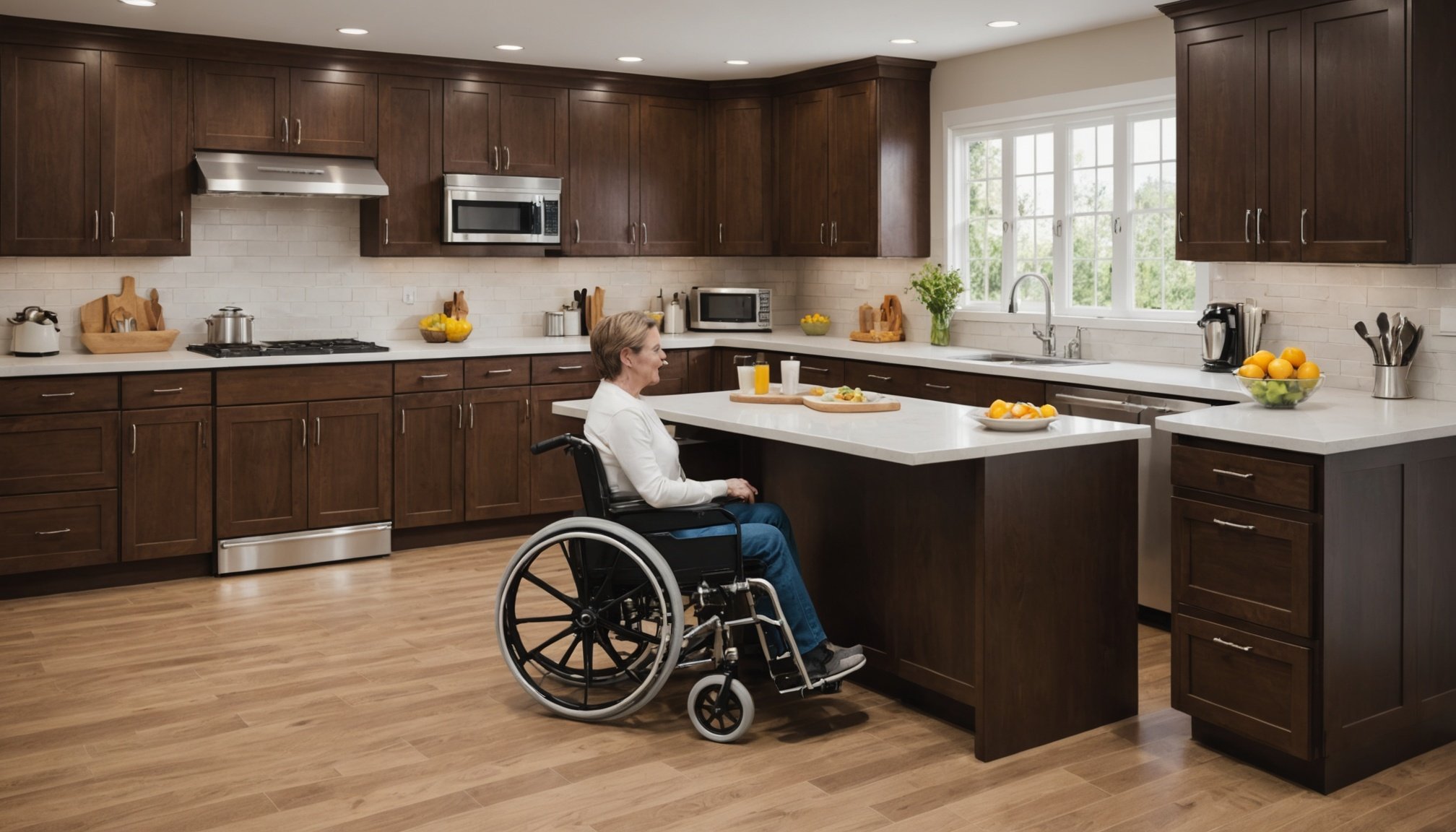Understanding Accessibility in Kitchen Design
When thinking about accessibility in kitchen design, it’s crucial to focus on creating wheelchair-friendly kitchens that are welcoming to all users. Inclusive design plays a vital role in ensuring that everyone, regardless of ability, can use the kitchen comfortably and efficiently.
Importance of Accessibility in Kitchen Layouts
Creating an accessible kitchen is not just about space; it’s about design that respects everyone’s needs. A wheelchair-friendly layout can include adjustable-height countertops, ample floor space, and lower shelves. This approach caters to those who use wheelchairs and enhances the experience for children and elderly individuals.
In parallel : Mastering multi-zone kitchen design: your essential guide to creating spaces for varied cooking experiences
Overview of Compliance Standards and Guidelines
When designing an accessible kitchen, adherence to specific standards such as the Americans with Disabilities Act (ADA) in the US is essential. These guidelines ensure that kitchens are accessible by setting requirements for counter heights, appliance accessibility, and clear floor space. Such compliance guarantees that kitchens serve a broader audience effectively.
Benefits of Inclusive Design for Various Users
Investing in an inclusive design yields benefits beyond compliance. A thoughtfully designed kitchen enhances usability, safety, and enjoyment for everyone who uses it. It also increases home value by appealing to a wider market, emphasizing accessibility as a desirable feature for all potential users.
This might interest you : Ultimate guide to preserving your wooden kitchen utensils: proven techniques for lasting durability
Layout Considerations for Wheelchair-Friendly Kitchens
Designing a kitchen layout to accommodate wheelchair users involves focusing on space optimization and ensuring seamless maneuverability. An ideal kitchen layout, favoured by experts, is the U-shape or L-shape. These configurations offer a practical and efficient arrangement by minimizing unnecessary movement and allowing easy access to all areas.
Space Requirements
For effective wheelchair access, experts recommend a minimum clear opening of 32 inches for doorways, ensuring enough room for easy entry and exit. A turning diameter of at least 60 inches is essential, providing safe and unobstructed movement. Additionally, counter heights should be between 28 and 34 inches, allowing for comfortable reach and use by wheelchair users.
Flow and Maneuverability
Creating distinct kitchen zones—such as preparation, cooking, and cleaning—is crucial. The transition between these zones should be smooth, avoiding tight corners and obstacles. Implementing sliding or pocket doors can enhance the flow, reducing potential barriers.
Essential factors include:
- Minimalism in kitchen design to reduce clutter
- Sufficient lighting for better visibility
- Utilizing pull-out shelves and drawers instead of traditional cabinets
By considering these aspects, a kitchen can achieve optimal functionality for individuals using wheelchairs, promoting independence and ease in daily tasks.
Counter Height and Work Surface Adjustments
Creating workspaces that consider counter height and ergonomic design is crucial for promoting accessibility and efficiency. For wheelchair users, the recommended counter height is approximately 28 to 34 inches. This range ensures that a person seated in a wheelchair can comfortably access the workstation without straining.
Adjustable surfaces are becoming increasingly popular as they provide flexibility for multiple users. These innovative height solutions allow counters to be raised and lowered according to the user’s preference, making them suitable for different activities and purposes. For example, an adjustable kitchen island can transition from a cooking surface to a dining table, accommodating both seated and standing users.
Ergonomic tools are essential for enhancing user efficiency. Items such as pull-out shelves or under-counter storage can be integrated into designs to minimize reach and reduce effort. They ensure that necessary tools and equipment are within easy reach, increasing the practicality of the workstation.
Incorporating these thoughtful design elements not only boosts workstation accessibility but also significantly enhances the quality of life for all users, ultimately promoting a more inclusive environment.
Accessible Storage Solutions
Creating an efficient and accessible storage system in your home requires thoughtful design and strategy. Incorporating cabinet accessibility is vital, ensuring that all necessary items are within reach. One effective strategy involves designing cabinetry and shelves with pull-out storage systems. These systems allow for easy access to items stored at the back of cabinets, reducing strain and effort.
Multifunctional storage solutions can also enhance accessibility. Opt for furniture pieces that offer hidden storage, like ottomans or benches with compartments. This not only saves space but keeps your essentials organized and easily accessible.
To maximize the use of space, utilize vertical storage. Installing shelves from floor to ceiling can create additional storage, but placement is key—keep frequently used items within arm’s reach. Adjustable shelving systems are another versatile option, allowing you to modify the height and arrangement based on your needs.
Organization tips further enhance accessibility. Group similar items together and use labels for easy identification. Clear containers ensure visibility of contents, reducing the time spent searching for items. By employing these strategies, you create a living space that is both organized and accessible.
Safety Features in Inclusive Kitchen Design
Incorporating crucial safety features in inclusive kitchen design ensures not only functionality but also peace of mind. For wheelchair-accessible kitchens, it’s essential to have ample space for maneuverability, enabling easy access to sinks, counters, and cooking areas. Adjustable-height countertops and sinks can significantly enhance usability and kitchen safety.
Non-slip surfaces are paramount in accident prevention, particularly for individuals with mobility challenges. Floors made of non-slip materials reduce the risk of falls, ensuring a safer environment. Another critical design element involves using rounded edges on countertops and furniture. This simple touch can help prevent injuries often caused by sharp edges in the event of an accidental bump or fall.
Emergency preparedness also plays a vital role in enhancing kitchen safety. Easily accessible emergency equipment, such as fire extinguishers and first aid kits, should be straightforward to reach without obstruction. Additionally, having clear paths and exits ensures swift evacuation during emergencies, further promoting a secure kitchen environment.
These measures, combined with thoughtful access considerations, make the kitchen a more inclusive and safer space for everyone. Embracing these safety features fosters a kitchen environment where functionality meets accident prevention, catering to the needs of all users.
Innovative Technology for Wheelchair Accessibility
The integration of smart kitchen technology is transforming accessibility for wheelchair users. With advancements in automation, kitchens are becoming not only functional but also more inclusive.
One significant development is the use of assistive devices—gadgets designed to enhance usability. Examples include automated cabinets that adjust height at the touch of a button and voice-activated appliances that reduce the need for physical interaction. These innovations are designed with accessibility in mind, offering greater autonomy for individuals with mobility constraints.
In addition, smart refrigerators that catalog contents and suggest recipes based on dietary needs can be a game-changer. These devices promote ease of use, ensuring that kitchens are adaptable to different accessibility requirements.
Looking ahead, the future of automation in kitchens promises even more sophisticated solutions. Trends indicate a move towards fully integrated systems, where appliances communicate seamlessly to anticipate user needs. This will likely involve advances in AI and sensor technology, making the kitchen a responsive environment that actively supports its users. As technology continues to evolve, inclusive kitchen design is set to revolutionize everyday living for those relying on assistive devices.
Design Inspirations and Case Studies
Exploring wheelchair-friendly kitchen designs offers a remarkable insight into how thoughtful planning transforms spaces. One standout case study demonstrates a kitchen featuring lowered countertops and pull-out shelves, making the area truly accessible. These real-life examples highlight solutions that cater to mobility needs without compromising on style.
Successful Wheelchair-Friendly Kitchen Designs
A thriving design is not only about aesthetics but also functionality. Kitchens exemplifying successful designs integrate adjustable cabinets and smart appliances. These modifications empower users to seamlessly manoeuvre and maintain independence while cooking.
Innovative Materials and Finishes Used
Innovation in materials can considerably enhance kitchen usability. For instance, anti-slip flooring and rounded edges improve safety, while stainless steel and acrylic finishes offer both durability and easy maintenance. These materials are specifically selected to balance style with functionality.
User Testimonials and Experiences
Real users confirm that accessible kitchen designs enrich their daily lives. One user shares how the customised layout improved meal preparation, reducing physical strain. Their feedback offers invaluable perspectives, affirming that tailored designs significantly impact comfort and efficiency in daily tasks.
Designing with these considerations ensures spaces are both inviting and pragmatic, encouraging independence and ease.
Expert Recommendations and Resources
Understanding accessibility and inclusive design can be greatly enhanced through expert advice and targeted resources. Accessibility experts and designers offer valuable insights that are essential for creating better, more accessible spaces.
Insights from Accessibility Experts and Designers
Learning from those who specialize in accessible design is crucial. Experts provide guidance on the best practices and principles, which can improve the usability of spaces for everyone. By following planning guides, designers can implement these insights directly into their projects.
Recommended Resources for Further Learning
To delve deeper, several design resources can aid in understanding the complex world of inclusive design. Books, online courses, and workshops provide comprehensive knowledge and skill development. These resources not only inform about technicalities but also inspire creativity and innovation.
Networking and Community Support
An often-overlooked aspect of inclusive design is the power of community. Networking with other professionals opens up avenues for sharing experiences and ideas. This community support is vital, as it fosters a collaborative environment where issues are addressed collectively. Engaging with these networks allows individuals to contribute meaningfully to inclusive design initiatives.
In conclusion, tapping into expert knowledge, utilizing educational resources, and nurturing community ties are all fundamental steps towards successful and inclusive designs.











